必修四Unit2语法Grammar V-ing做主语和宾语
- 格式:ppt
- 大小:1.02 MB
- 文档页数:59
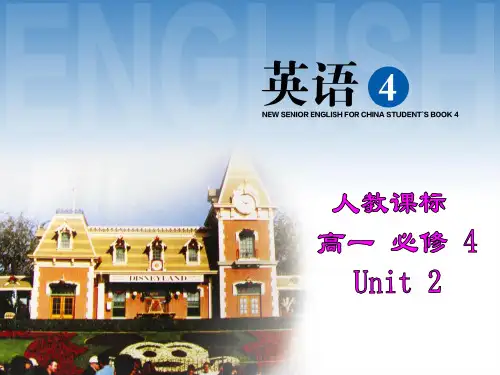
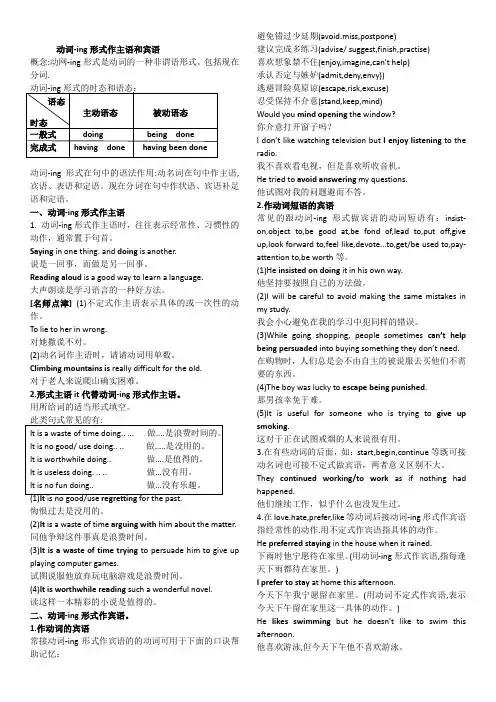
动词-ing形式作主语和宾语概念:动网-ing形式是动词的一种非谓语形式。
包括现在分词.动词-ing形式的时态和语态:语态主动语态被动语态时态一般式doing being done完成式having done having been done动词-ing形式在句中的语法作用:动名词在句中作主语,宾语、表语和定语。
现在分词在句中作状语、宾语补足语和定语。
一、动词-ing形式作主语1. 动词-ing形式作主语时,往往表示经常性、习惯性的动作,通常置于句首。
Saying in one thing. and doing is another.说是一回事,而做是另一回事。
Reading aloud is a good way to learn a language.大声朗读是学习语言的一种好方法。
[名师点津](1)不定式作主语表示具体的或一次性的动作。
To lie to her in wrong.对她撒谎不对。
(2)动名词作主语时,请请动词用单数。
Climbing mountains is really difficult for the old.对于老人来说爬山确实困难。
2.形式主语it代替动词-ing形式作主语。
用所给词的适当形式填空。
此类句式常见的有:It is a waste of time doing.. ... 做....是浪费时间的。
It is no good/ use doing.. .. 做.....是没用的。
It is worthwhile doing.. 做....是值得的。
It is useless doing. .. .. 做...没有用。
It is no fun doing.. 做...没有乐趣。
悔恨过去是没用的。
(2)It is a waste of time arguing with him about the matter.同他争辩这件事真是浪费时间。
(3)It is a waste of time trying to persuade him to give up playing computer games.试图说服他放弃玩电脑游戏是浪费时间。
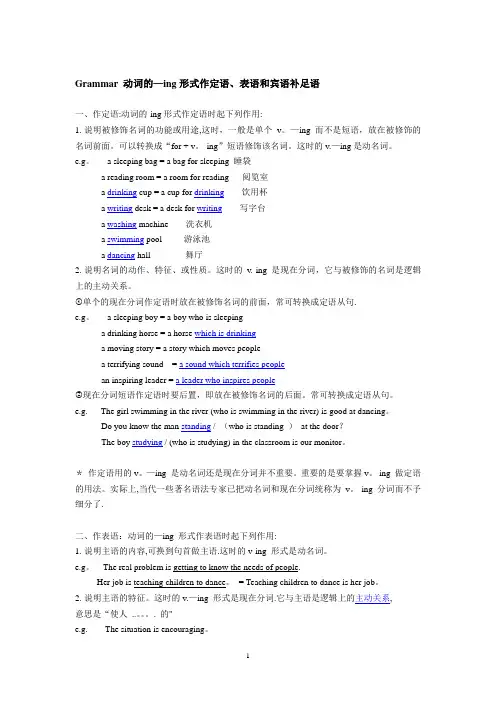
Grammar 动词的—ing形式作定语、表语和宾语补足语一、作定语:动词的-ing形式作定语时起下列作用:1.说明被修饰名词的功能或用途,这时,一般是单个v。
—ing 而不是短语,放在被修饰的名词前面。
可以转换成“for + v。
-ing”短语修饰该名词。
这时的v.—ing是动名词。
e.g。
a sleeping bag = a bag for sleeping 睡袋a reading room = a room for reading 阅览室a drinking cup = a cup for drinking饮用杯a writing desk = a desk for writing写字台a washing machine 洗衣机a swimming pool 游泳池a dancing hall 舞厅2.说明名词的动作、特征、或性质。
这时的v.-ing 是现在分词,它与被修饰的名词是逻辑上的主动关系。
①单个的现在分词作定语时放在被修饰名词的前面,常可转换成定语从句.e.g。
a sleeping boy = a boy who is sleepinga drinking horse = a horse which is drinkinga moving story = a story which moves peoplea terrifying sound = a sound which terrifies peoplean inspiring leader = a leader who inspires people②现在分词短语作定语时要后置,即放在被修饰名词的后面。
常可转换成定语从句。
e.g. The girl swimming in the river (who is swimming in the river) is good at dancing。
Do you know the man standing / (who is standing )at the door?The boy studying / (who is studying) in the classroom is our monitor。
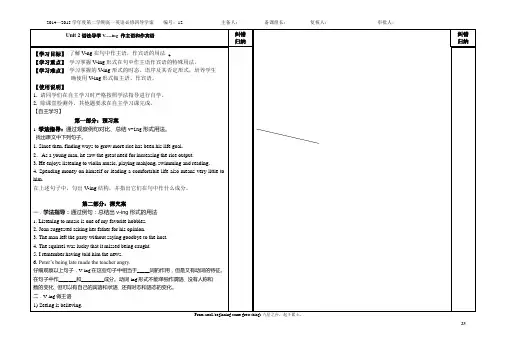
From small beginning come great things.九层之台,起于累土。
}she is an experienced one.? that c 2) Talking is easier than doing. 3) It's no use complaining.4) It's no good worrying about it. 5) It's worthwhile making the experiment. 6) Not being late is a good habit. 勾出V-ing 并归纳: V-ing 做主语,谓语动词用______数。
3),4),5)句中,it 是__________, 真正的主语是__________.否定形式为__________ 句型1. It+be +no use/ no good/ useless doing 做...是没有用的/没有好处的 句型2. It +be+ worthwhile/ a waste of time (in)doing 做....是值得的/浪费时间的 句型 3.There is/ was no point doing sth 做……是无意义的 有时态和语态的变化。
语态时态 主动语态被动语态一般式 doing完成式Having been done①动名词的一般式表示动作或状态与谓语动词的动作同时发生,或者表示一种无时间性限制的经常性、习惯性的动作或状态。
②完成式动名词的完成式表示动作或状态先于谓语动词的动作或状态。
练习:完成课本P13 exercise 2 V-ing 做宾语1) As a young man, he saw the great need for increasing the rice output.2) Dr Yuan searched for a way to increase rice harvests without expanding the area of the fields.3) He enjoys listening to violin music, playing mah-jong, swimming and reading.4) Dr Yuan awoke from his dream with the hope of producing a kind of rice that could feed more people. 勾出V-ing 并归纳:V-ing 既可作_______词的宾语,也可作_______词的宾语。
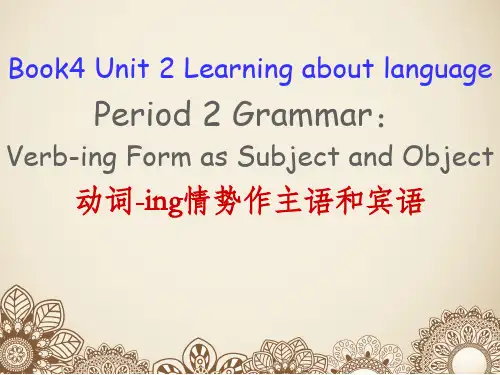
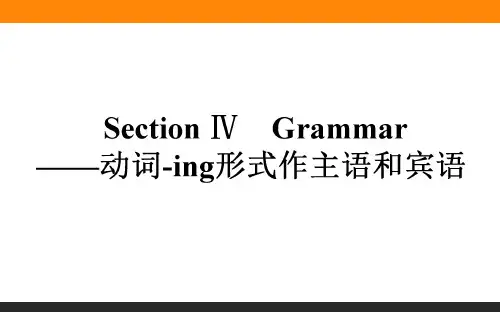
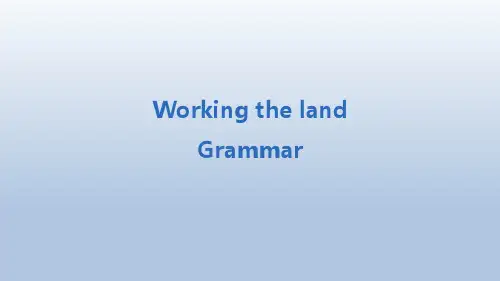
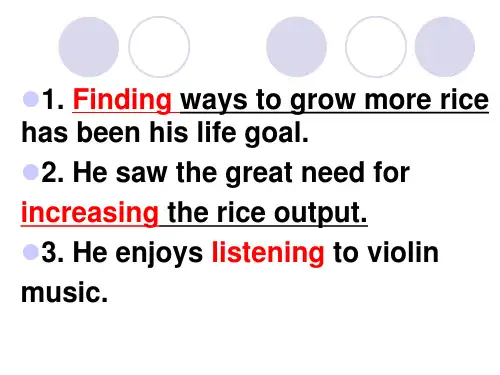
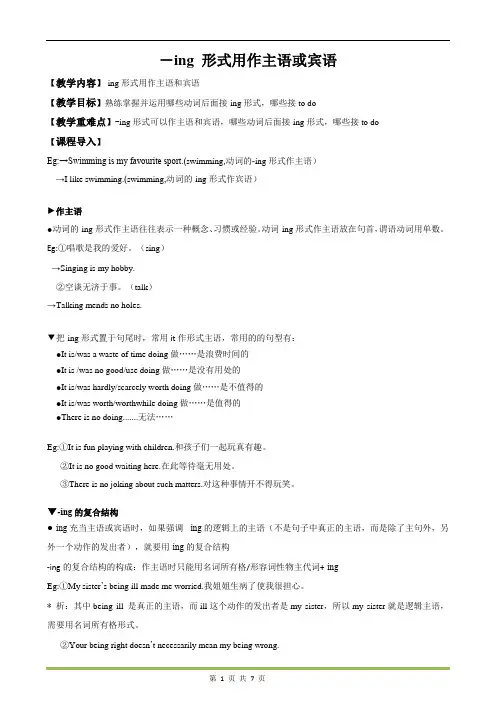
-ing 形式用作主语或宾语【教学内容】-ing形式用作主语和宾语【教学目标】熟练掌握并运用哪些动词后面接-ing形式,哪些接to do【教学重难点】-ing形式可以作主语和宾语,哪些动词后面接-ing形式,哪些接to do【课程导入】Eg:→Swimming is my favourite sport.(swimming,动词的-ing形式作主语)→I like swimming.(swimming,动词的-ing形式作宾语)►作主语●动词的-ing形式作主语往往表示一种概念、习惯或经验。
动词-ing形式作主语放在句首,谓语动词用单数。
Eg:①唱歌是我的爱好。
(sing)→Singing is my hobby.②空谈无济于事。
(talk)→Talking mends no holes.▼把-ing形式置于句尾时,常用it作形式主语,常用的的句型有:●It is/was a waste of time doing做……是浪费时间的●It is /was no good/use doing做……是没有用处的●It is/was hardly/scarcely worth doing做……是不值得的●It is/was worth/worthwhile doing做……是值得的●There is no doing.......无法……Eg:①It is fun playing with children.和孩子们一起玩真有趣。
②It is no good waiting here.在此等待毫无用处。
③There is no joking about such matters.对这种事情开不得玩笑。
▼-ing的复合结构●-ing充当主语或宾语时,如果强调-ing的逻辑上的主语(不是句子中真正的主语,而是除了主句外,另外一个动作的发出者),就要用-ing的复合结构-ing的复合结构的构成:作主语时只能用名词所有格/形容词性物主代词+-ingEg:①My sister’s being ill made me worried.我姐姐生病了使我很担心。
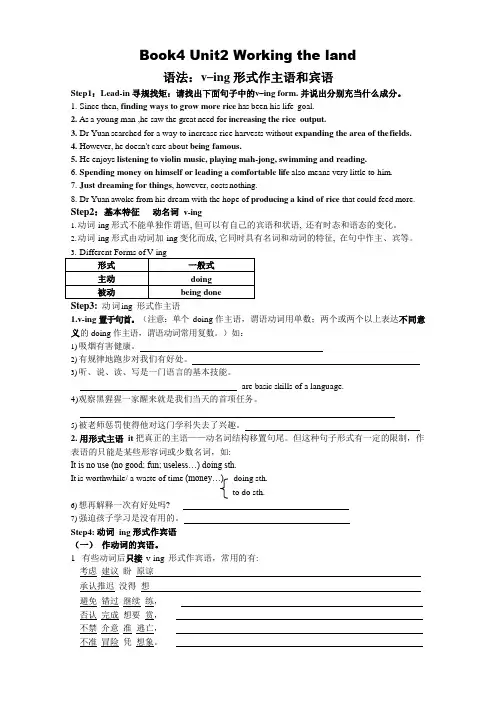
Book4 Unit2 Working the land语法:v–ing 形式作主语和宾语Step1:Lead-in 寻规找矩:请找出下面句子中的v–ing form. 并说出分别充当什么成分。
1.Since then, finding ways to grow more rice has been his life goal.2.As a young man ,he saw the great need for increasing the rice output.3.Dr Yuan searched for a way to increase rice harvests without expanding the area of the f ields.4.However, he doesn't care about being famous.5.He enjoys listening to violin music, playing mah-jong, swimming and reading.6.Spending money on himself or leading a comfortable life also means very little to him.7.Just dreaming for things, however, costs nothing.8.Dr Yuan awoke from his dream with the hope of producing a kind of rice that could feed more. Step2:基本特征动名词v-ing1.动词-ing 形式不能单独作谓语, 但可以有自己的宾语和状语, 还有时态和语态的变化。
2.动词-ing 形式由动词加-ing 变化而成, 它同时具有名词和动词的特征, 在句中作主、宾等。
动词ing 形式作主语1.v-ing 置于句首。
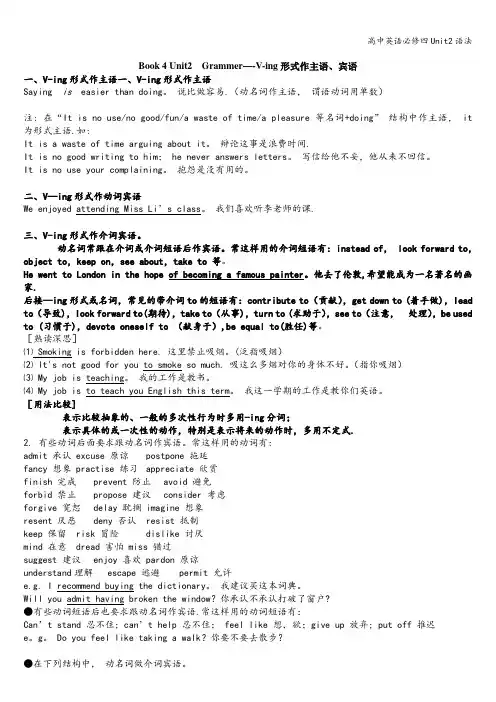
Book 4 Unit2 Grammer—-V-ing形式作主语、宾语一、V-ing形式作主语一、V-ing形式作主语Saying is easier than doing。
说比做容易.(动名词作主语,谓语动词用单数)注: 在“It is no use/no good/fun/a waste of time/a pleasure 等名词+doing” 结构中作主语, it 为形式主语.如:It is a waste of time arguing about it。
辩论这事是浪费时间.It is no good writing to him; he never answers letters。
写信给他不妥,他从来不回信。
It is no use your complaining。
抱怨是没有用的。
二、V—ing形式作动词宾语We enjoyed attending Miss Li’s class。
我们喜欢听李老师的课.三、V-ing形式作介词宾语。
动名词常跟在介词或介词短语后作宾语。
常这样用的介词短语有:instead of, look forward to,object to,keep on,see about,take to 等。
He went to London in the hope of becoming a famous painter。
他去了伦敦,希望能成为一名著名的画家.后接—ing形式或名词,常见的带介词to的短语有:contribute to(贡献),get down to (着手做),lead to(导致),look forward to(期待),take to(从事),turn to (求助于),see to(注意,处理),be used to (习惯于),devote oneself to (献身于),be equal to(胜任)等。
[熟读深思]⑴ Smoking is forbidden here. 这里禁止吸烟。
必修四Unit2动词-ing形式作主语和宾语动名词作主语时,句子有三种形式:①动名词直接置于句首主语的位置上。
Playing tricks on others is something we should never do.②用形式主语it,把真正作主语动的名词结构移置句尾。
但这种句子形式有一定的限制,作表语的只能是某些形容词或少数名词,如useful, useless, good, fun, no use, worth等。
如:It’s worth making the effort.这事值得去做。
It is useless trying to argue with Shylock. 和夏洛克争辩是没有什么用的。
Is it any good trying to explain? 想再解释一次有好处吗?It is pleasant working with you. 跟你在一起工作是令人愉快的。
③在there be结构中作主语,这种结构的意思相当于“It is impossible to do…”如:There is no hiding of evil but not to do it. 若要人不知,除非己莫为。
Here is no joking about such matter. 这种事开不得玩笑。
There was no knowing when he would leave. 无法知道他什么时候离开。
动名词作主语与不定式作主语的区别动名词表示的动作通常是一个泛指的动作,不定式则通常表示具体的动作。
如:As a child, she felt that visiting sick people was a duty and a pleasure.还是个孩子的时侯,她就觉得探视病人是一种责任,也是一种愉悦。
To be a guest in an American home will be a good experience for me.到美国人家里做客对我来说将是一个极好的经历。
必修4Unit 2 Working the landGrammar: the v–ing form as the Subject and Object(v-ing 形式作主语和宾语)Step I. Lead-in & Presentation.(观察下列句子,划出各句的主谓宾或者主系表结构)1.Money is not everything. 金钱不是万能的。
2. Seeing is believing. 眼见为实。
3.A good beginning makes a good ending.善始者善终4. I like reading China Daily. 我喜欢读《中国日报》5.Lily is fond of reading novels. 李丽喜欢读小说。
【Task】以上各句子的主语分别是______、________、___________、_______和______。
其中1、2句的表语分别是_______ 和_________.那么3、4、和5句的宾语分别是___________、__________ 和___________.【小结】可以看出,英语句子主语和宾语除了由名词代词等充当,还可以由v-ing 形式来充当。
V-ing 作主语和宾语的用法就是我们今天要学习的重点。
Step II. the v–ing form as the Subject and Object (v-ing 形式作主语和宾语)v-ing 形式作主语1.v-ing置于句首。
(注意:单个v-ing作主语,谓语动词用单数;两个或两个以上表达不同意义的v-ing作主语,谓语动词常用复数。
)如:⑴Smoking is harmful to our health.吸烟有害健康。
⑵_________ (run) regularly does good to us .有规律地跑步对我们有好处。
⑶Watching TV and reading books are really interesting.看电视和读书真有趣。
必修4 Unit2 语法动词的-ing形式作主语和宾语非谓语动词分为动名词(即:v-ing)、动词不定式和分词(现在分词和过去分词)三种。
非谓语在句中不能作谓语,所以没有人称和数的变化,但有时态和语态的变化。
非谓语在句中可作主语、宾语、表语、定语、宾语补足语和状语。
本单元我们主要学习动名词作主语和宾语的用法。
一、动词的-ing形式作主语1. 动词的-ing形式作主语往往表示经常性、习惯性的动作,谓语用单数。
①Talking to him is talking to a wall. 和他说话等于对牛弹琴。
②Climbing mountains is really fun. 爬山真是有趣。
③Seeing is believing. 眼见为实④Listening to music is one of my favorite hobbies.温馨提示:动词的-ing和不定式都可以作主语,动词的-ing作主语表示经常性、习惯性的动作,不定式作主语往往表示具体的或一次性的动作,作宾语时的情况也是如此。
①To watch a football match is what I want to do today.(to do做主语表示一次性或具体的动作)②Swimming is great exercise.游泳是项很好的锻炼。
③To clean the classroom is his job today.2.常用-ing形式作主语的句型有:(1)It is/was +adj. +doing sth.It is/was worthwhile doing 做……是值得的(2) It +be +a waste of time doing 做……是浪费时间(3) It is/was+ no +n.+ doing sth.It is/was no use doing 做……没用处It is/was no good doing 做……没有好处(4) 在there be 句型中There is/was +no +doing (joking/ knowing…) 无法……,不允许……There is/was nothing worse than doing 没有比……更糟的There is/was +no +n.+ doin g→There is/was no sense in doing 做……没有道理There is/was no point doing 做……无意义e.g.①It is no use/no good crying over spilt milk. 覆水难收②It is a waste of time persuading such a person to join us.③There is nothing worse than failing in the exam.没有比考试不及格更糟糕的事情了。